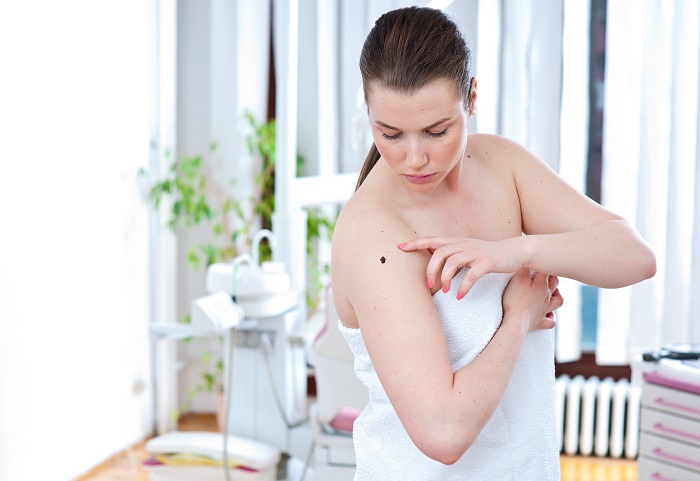According to Dr. Valerie Truong, a U.S. Dermatology Partners Mohs Surgeon servicing patients in Dallas, Plano, Sherman and Corsicana, Texas, “Some of the most common questions we receive are about the causes of and risks for developing skin cancer. As dermatologists, educating and increasing awareness about this health concern is one of our main goals.”
In this blog, Dr. Truong takes the time to discuss skin cancer causes, risk factors, prevention, and the importance of regular screenings.
What Causes Skin Cancer?
Cancer occurs when a cell’s DNA is damaged. This damage causes the uncontrolled growth of mutated skin cells. In contrast to healthy and normal skin cells, which are reproduced in a precise and orderly manner, damaged cells reproduce rapidly, without any particular order. In most cases, this damage is caused by exposure to UV radiation. The UV radiation acquired throughout one’s lifetime (including exposure in childhood) can increase the risk of developing skin cancer. Blistering sunburns and exposure to tanning beds have shown to increase the risk of all types of skin cancers. Other potential causes of skin cancer include chemicals, x-rays, and injuries leading to a chronic scar, such as a burn.
How Can I Tell if It’s Skin Cancer or a Mole?
Moles, freckles, sunspots, and other irregularities in the appearance of your skin can be perfectly healthy and natural. So, how can you tell when a spot is something to worry about?
Remember your ABCDE’s!
- A – Asymmetry – One half is unlike the other half
- B – Border – The outline of the spot is uneven, jagged, scalloped, blurred, or poorly defined
- C – Color – There are multiple shades of color
- D – Diameter – Spots that are greater in diameter than 6 mm (about the size of a pencil eraser)
- E – Evolving – When moles or skin spots are changing in size, color, or shape
Other signs of skin cancer include an enlarging skin-colored or pink growth, a non-healing wound, a spot that bleeds easily with minimal trauma, and any spot that is different from your other moles.
Are There Factors that Increase My Risk for Skin Cancer?
Research shows that the vast majority of skin cancer cases are caused by exposure to Ultraviolet (UV) radiation. Some of the risk factors that increase your chances for skin cancer include:
- Skin tone – Skin cancer can affect anyone regardless of skin color, however, those with lighter skin tones have less melanin to protect them against UV radiation, making them more prone to developing skin cancers.
- Sunburns – Sun damage is cumulative, therefore experiencing repeated sunburns can exponentially increase the risk for skin cancer. Even one blistering sunburn in your lifetime can double the risk of developing melanoma.
- Lifetime sun exposure – because sun damage is cumulative, extended or regular exposure to UV radiation (working outdoors, tanning regularly, etc.) is a big risk factor for skin cancer.
- Climate – Living in sunny areas or places with a high-altitude can increase the intensity of UV radiation and, therefore, your risk for cancer.
- Moles and freckles – People who have numerous moles and freckles, especially abnormal moles, are at greater risk.
- Health history – A personal or family history of skin cancer increases future risk.
- Exposure to certain substances – Radiation, chemicals, and toxins can increase the risk of skin cancer, especially for people who regularly work with potential carcinogens (arsenic, industrial tar, etc.).
- Weakened immune systems – Those who have immune suppression due to poor health, chronic immune conditions, or certain medication usage may be at an increased risk. Organ transplant recipients are also at a significantly higher risk of developing skin cancers as the anti-rejection medication they take to protect their transplanted organs compromises the immune system.
How do I Prevent Skin Cancer?
Exposure to UV light is the most preventable risk factor for all skin cancers. The easiest, yet most significant way to reduce your skin cancer risk is to protect yourself from the sun.
Some of the ways to protect your skin from harmful UVA/UVB rays include:
- Wear a broad-spectrum sunscreen with an SPF of at least 30 every day (even when it’s cold or cloudy outside)
- Stay out of the sun during peak hours (10 am to 4 pm)
- Reapply sunscreen at least every two hours when you’re out in the sun
- Avoid tanning booths
- Take breaks from the sun when outdoors for long periods of time
- Wear hats to protect your scalp and face from direct sun exposure
- Consider wearing long sleeves and/or pants to protect your skin from sun exposure
Should I Perform a Self-Exam?
Absolutely. We recommend that people perform self-exams once a month. These regular skin checks mean you’ll know right away if there are any changes in the appearance, texture, or health of your skin. The earlier we are able to detect the warning signs of skin cancer, the more likely it is to be treatable. The American Academy of Dermatology has created a simple skin cancer self-assessment chart that you can print to make the process easier. You can even record where you have moles, freckles, and other irregularities in your skin’s surface. Then, you can note any changes in size, shape, color, or texture. A skin cancer self-exam is very simple to perform, following the instructions below:
- Stand in front of a full-sized mirror with good lighting.
- Use a hand mirror as necessary to see difficult to view parts of the body.
- Carefully examine your face, scalp, and neck.
- Lifting your arms, examine the front, back, and sides of your body.
- Carefully examine your arms and legs. Flex your elbows and knees, looking for pockmarks and other irregularities.
- Don’t forget to check your hands and the bottoms of your feet!
Do I Need to Visit a Dermatologist for a Skin Cancer Screening?
In addition to regular self-exams at home, we encourage patients to visit us at least once a year for a professional dermatology exam. During these annual assessments, we’ll screen for skin cancer and other concerns. Annual assessments are especially important for those who are at increased risk for skin cancer. You can take our online risk assessment to find out more about your individual risk level. If you want to schedule your annual dermatology exam and you live in the North Texas area, Dr. Truong would be happy to schedule a time to see you. If you’re outside of the North Texas area, use our online request form to get in contact with the U.S. Dermatology Partners location near your home. One of our knowledgeable team members will be in touch soon to schedule your first visit.
Find a location near me
or


